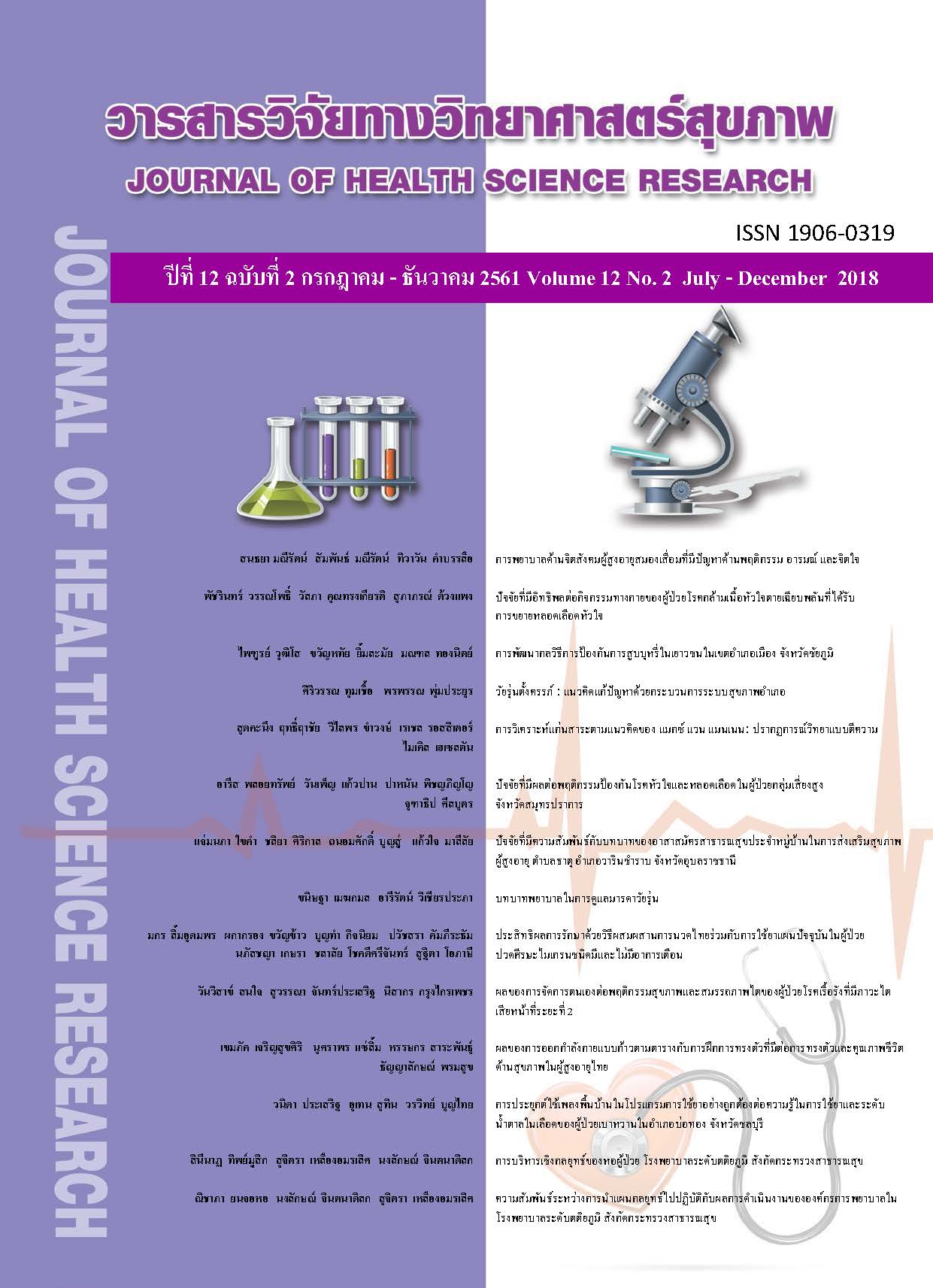ผลของการออกกำลังกายแบบก้าวตามตารางกับการฝึกการทรงตัว ที่มีต่อการทรงตัวและคุณภาพชีวิตด้านสุขภาพในผู้สูงอายุไทย
Main Article Content
บทคัดย่อ
ประเทศไทยมีจำนวนผู้สูงอายุเพิ่มขึ้นอย่างต่อเนื่อง ปัญหาการทรงตัวในผู้สูงอายุส่งผลต่อคุณภาพชีวิตด้านสุขภาพ การออกกำลังกายเป็นวิธีการหนึ่งซึ่งช่วยสร้างเสริมสุขภาพที่ได้ผลดี งานวิจัยนี้มีวัตถุประสงค์เพื่อศึกษาและเปรียบเทียบผลของการออกกำลังกายแบบก้าวตามตารางกับการฝึกการทรงตัวที่มีต่อการทรงตัวและคุณภาพชีวิตด้านสุขภาพในผู้สูงอายุไทย เป็นการวิจัยกึ่งทดลองแบบสองกลุ่มวัดก่อนและหลัง กลุ่มตัวอย่างคือ ผู้สูงอายุจำนวน 19 คน เครื่องมือที่ใช้ในการทดลองคือ โปรแกรมการออกกำลังกายแบบก้าวตามตารางกับการฝึกการทรงตัว เครื่องมือที่ใช้ในการเก็บรวบรวมข้อมูล คือ แบบสอบถามคุณภาพชีวิต แบบบันทึกการทดสอบ single leg stance และ Time up and Go test เก็บข้อมูลระหว่างเดือนพฤศจิกายน พ.ศ. 2560 ถึงเดือนมกราคม พ.ศ. 2561 วิเคราะห์ข้อมูลโดยใช้ค่าเฉลี่ย ส่วนเบี่ยงเบนมาตรฐาน ค่ามัธยฐานและสถิติ Independent t-test, Wilcoxon singed-rank test และ Mann-Whitney U test
ผลวิจัยพบว่าผู้เข้าร่วมวิจัยทั้งสองกลุ่มมีการทรงตัวขณะเคลื่อนไหวเพิ่มขึ้นอย่างมีนัยสำคัญทางสถิติที่ระดับ .05 ผู้เข้าร่วมวิจัยกลุ่มออกกำลังกายแบบก้าวตามตารางมีการทรงตัวขณะอยู่นิ่งเพิ่มขึ้นและมีปัญหาคุณภาพชีวิตด้านสุขภาพด้านการเคลื่อนไหวและด้านการดูแลตนเองลดลงอย่างมีนัยสำคัญทางสถิติที่ระดับ .05 สำหรับผู้เข้าร่วมวิจัยกลุ่มฝึกการทรงตัวมีปัญหาคุณภาพชีวิตด้านสุขภาพด้านความวิตกกังวลหรือความซึมเศร้าลดลงอย่างมีนัยสำคัญทางสถิติที่ระดับ .05 เมื่อเปรียบเทียบความแตกต่างระหว่างกลุ่มพบว่าเฉพาะการทรงตัวขณะเคลื่อนไหวมีความแตกต่างกันอย่างมีนัยสำคัญทางสถิติที่ระดับ .05 ดังนั้นการออกกำลังกายแบบก้าวตามตารางกับการฝึกการทรงตัวมีผลต่อการทรงตัวและคุณภาพชีวิตด้านสุขภาพ
Downloads
Article Details
บทความที่ได้รับการตีพิมพ์เป็นลิขสิทธิ์ของวิทยาลัยพยาบาลบรมราชชนนี จังหวัดนนทบุรี
ข้อความที่ปรากฏในบทความแต่ละเรื่องในวารสารวิชาการเล่มนี้เป็นความคิดเห็นส่วนตัวของผู้เขียนแต่ละท่านไม่เกี่ยวข้องกับวิทยาลัยพยาบาลบรมราชชนนี จังหวัดนนทบุรี และคณาจารย์ท่านอื่น ในวิทยาลัยฯ แต่อย่างใด ความรับผิดชอบองค์ประกอบทั้งหมดของบทความแต่ละเรื่องเป็นของผู้เขียนแต่ละท่าน หากมีความผิดพลาดใด ๆ ผู้เขียนแต่ละท่านจะรับผิดชอบบทความของตนเองแต่ผู้เดียว
เอกสารอ้างอิง
2.Webb RC, Inscho EW. Age-related changes in the cardiovascular system. In: Prisant LM, editor. Hypertension in the elderly. Totowa, NJ: Humana Press; 2005. p. 11-21.
3.Ratanai S. Elder care manual. Bangkok: Saengdao Publishing House; 2012. (in Thai).
4.Assantachai P. Common health problems in elderly and prevention. 2nd ed. Bangkok: Department of Preventive and Social Medicine, Faculty of Medicine Siriraj Hospital, Mahidol University; 2011. (in Thai).
5.Salzman B. Gait and balance disorders in older adults. Am Fam Physician. 2010;82(1):61-8.
6.Bhanusali H, Vardhan V, Palekar T, Khandare S. Comparative study on the effect of square stepping exercises versus balance training exercises on fear of fall and balance in elderly population. International Journal of Physiotherapy and Research. 2015;4(1):1352-9.
7. Khemapech S. Exercise for health in older adult. Journal of The Police Nurses. 2016;8(2):201-11. (in Thai).
8.Ministry of Public Health. The twelfth national economic and social development plan [Internet]. 2017 [cited 2018 Oct 13]; Available from: http://bps.moph. go.th/new_bps/sites/default/files/HealthPlan12_2560_2564.pdf
9. Amruklert W, Fumaneechort O, Ananchaisup T, Chamroonkiadtikun P. Care for elderly, disable, terminal-illness in primary care. Songkhla: Department of Community Medicine, Faculty of Medicine, Prince of Songkla University; 2015. (in Thai).
10. Fuster V, Walsh RA, O’Rourke RA, Poole-Wilson P. Hurst’s the heart. 12thed. New York: McGraw-Hill Medical; 2007.
11.Gulsatitporn S. Physiotherapy in elderly. 2nd ed. Bangkok: Offset Press; 2006. (in Thai).
12. Fisseha B, Janakiraman B, Yitayeh A, ravichandran H. Effect of square stepping exercise for older adults to prevent fall and injury related to fall: Systematic review and meta-analysis of current evidences. J Exerc Rehabil. 2017;13(1):23-9.
13.El Haber N, Erbas B, Hill KD, Wark JD. Relationship between age and measures of balance, strength and gait: Linear and non-linear analyses. Clin Sci (Lond). 2008;114(12):719-27.
14.Krejcie RV, Morgan DW. Determining sample size for research activities. Educ Psychol Meas. 1970;30(3):607-10.
15.Podsiadlo D, Richardson S. The timed “Up & Go”: A test of basic functional mobility for frail elderly persons. J Am Geriatr Soc. 1991;39(2):142-8.
16.Janssen MF, Pickard AS, Golicki D, Niewada M, Scalone L, Swinburn P, et al. Measurement properties of the EQ-5D-5L compared to EQ-5D-3L across eight patient groups: A multi-country study. Qual Life Res. 2013;22(7):1717-27.
17. Laukongtam W, Phimtra S, Kongsuk T, Rungreangkulkij S. The effects of group happy reminiscence therapy on depressive symptoms in Thai older people with major depressive disorder. The Journal of Psychiatric Nursing and Mental Health. 2015;29(2):12-27. (in Thai).
18.Pattanaphesaj J, Thavorncharoensap M. Policy brief: The Thai version of the EQ-5D-5L health questionnaire (Thai version). Health Intervention and Technology Assessment Program (HITAP). 2015;3(24):1-4. (in Thai).
19.Viravan T. Effect of combination exercise on balance in elderly, Bungkum District, Bangkok. Journal of Public Health. 2012;42(2):44-53. (in Thai).
20. Shigematsu R, Okura T, Nakagaichi M, Tanaka K, Sakai T, Kitazumi S, et al. Square-stepping exercise and fall risk factors in older adults: A single-blind, randomized controlled trial. J Gerontol A Biol Sci Med Sci. 2008;63(1):76-82.
21.Amatachaya S, Thaweewannakij T, Srisim K, Wongsa S, Phiwjinda K, Mato L, et al. Sufficient activity is important for mobility of well-functioning elderly. Chulalongkorn Medical Journal. 2011;55(3):221-31. (in Thai).
22.Charoensuksiri K, Charoensuksiri S. A health-related quality of life and activities of daily living of Thai elderly people in Pathumthani Social Welfare Development Center for Older Persons. Journal of Associated Medical Sciences. 2017;50(3):516-24. (in Thai).


